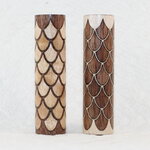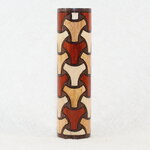Hello Ken. Being you will be showing us many more of your designs and now selling them, how about a little tutorial on how these are accomplished. It is not like you are giving away any secrets because we all do not have access to lasers. Do you have to size each colored wood exactly as the others used in the blank.Are the woods rounded first or are they cut from flat form. Do you have to cut each colored wood the same so that basically you could mix and match any combo you want. Would like to see some of the steps needed to make these. Would make the blanks more interesting.
John, I really have no trade secrets to hide concerning the way I make blanks. I've been doing this work long enough to know that everybody doesn't really appreciate it. I can understand that. I'm not here to change the way people feel about technologically processed blanks. My objective is to show what is possible using technology and a little imagination. I am open to questions on my processes and the tools that I use, with the exception of some of the aspects of the laser rotary that I built to do this type work. I would hope I could peacefully coexist with others in forums like this and have a mutual appreciation of the way we make blanks. The next blank I post to this forum I will try to photo document the steps if there is truly an interest in what I do. Having said that here is the step by step procedure in a nutshell. If you have questions, please do ask.
Step 1. Start with square blanks and cut to a standard length
(on the bandsaw). For Sierras and most blanks this is 2 1/2". I
will batch anywhere from 20 to 100 blanks at a time.
Step 2. Drill all the blanks on the drill press to tube size.
Step 3. Using bushings that are sized to the hole size in the
blank, the blanks are rounded down on the metal lathe to
standard diameters. This requires about 4 passes when taking
off 50 thousandths per pass from the radius. 5/8" is used for
most pens such as Sierras, Cigar and the lower section of the Jr
Series. 3/4" is used for the cap section of the Jr series.
Accounting for the through hole this leaves 1/8" or less of wood
to be cut through.
Step 4. The blanks are mounted on the laser rotary using center
drilled aluminum rods that are sized to the through holes. The
headstock end of the rod is knurled to give a little extra byte
to hold the blank. The aluminum rod is secured to the mandrel
using spacer bushings and a nut on the tailstock end of the
mandrel. Any cuts that are done all the way around the blank are
done from the tailstock end and progress towards the headstock.
Step 5. The blanks are cut on the rotary with the laser. There
are two types of blanks. The first is the skeleton blank, its
purpose is to hold the inlays. The second type of blank is the
inlays themselves. For inlay blanks I don't use the same
artwork to cut both types of blanks. The artwork for the inlays
is laser kerf compensated so to give a friction fit of the
inlays into the skeleton blank. Laser kerf compensation is done
by offsetting the skeleton drawings by 0.007" in the outward
direction. This makes them large enough to fit snugly into the cutouts
in the skeleton blanks. The only exception to this would be
puzzle piece blanks. The same cuts are used on all of the
puzzle blanks to allow for a little "wiggle" to get them apart
and back together in their mixed color format.
Because I compensate for the laser kerf, I have to cut two blanks for every one finished blank. Some may think that is a waste, I think it's worth the cost and time to have inlays that actually more closely fit the cutouts. I hope that this has answered most of your questions.


